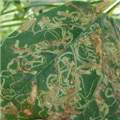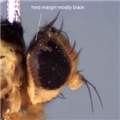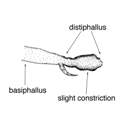Nomenclature
Liriomyza sativae Blanchard 1938
Agromyza subpusilla Frost 1943Liriomyza verbenicola Hering 1951Liriomyza pullata Frick 1952Liriomyza canomarginis Frick 1952Liriomyza minutiseta Frick 1952Liriomyza propepusilla Frost 1954Liriomyza munda Frick 1957Liriomyza guytona Freeman 1958 Lemurimyza lycopersicae Pla & de la Cruz 1981
Common names:vegetable leafminer, American leafminer, chrysanthemum leafminer, serpentine vegetable leafminer, melon leafminer
Hosts
Liriomyza sativae is a polyphagous pest of many vegetable and flower crops (Spencer 1973, 1990). It has been recorded from nine plant families, although its preferred hosts tend to be in the Cucurbitaceae, Fabaceae and Solanaceae (Spencer 1973, 1981, 1990).
Distribution
Asia: China, India, Indonesia, Iran, Israel, Japan, Jordan, Malaysia, Oman, Philippines, Saudi Arabia, Sri Lanka, Thailand, Timor Leste, Turkey, Uzbekistan, Vietnam, Yemen Europe: Estonia, Finland, United Kingdom Africa: Cameroon, Egypt, Nigeria, South Africa, Sudan, Zimbabwe North America: Canada, Mexico, USA Central America: Bahamas, Barbados, Costa Rica, Cuba, Dominica, Dominican Republic, Guadeloupe, Guatemala, Honduras, Jamaica, Martinique, Montserrat, Netherlands Antilles, Nicaragua, Panama, Puerto Rico, Saint Kitts and Nevis, Saint Lucia, Trinidad and Tobago South America: Argentina, Brazil, Chile, Colombia, French Guiana, Peru, Venezuela Oceania: American Samoa, Australia (Torres Strait 2008; Cape York 2015), Cook Islands, Federated States of Micronesia, French Polynesia, Guam, New Caledonia, Northern Mariana Islands, Papua New Guinea (2011), Samoa, Vanuatu
Based on data from CABI Invasive Species Compendium (2019) except where dated.
Key characters
Head with frons and orbits yellow, third antennal segment yellow, femora bright yellow, mesonotum black, shining, outer vertical bristle on black ground and inner vertical bristle on yellow. Wing with last section of CuA1 3-4 times length of penultimate section, wing length 1.3-1.7 mm. Aedeagus: distiphallus with one distal bulb with a slight constriction between upper and lower halves. Detailed descriptions can be found in Dempewolf (2004), EPPO (2005), Spencer (1965, 1973) and Shiao (2004). Key diagnostic features are shown in the PaDIL diagnostic images.
Notes
Since the early 1990s, there has been a rapid movement of L. sativae and L. huidobrensis eastward through tropical and sub-tropical areas of Asia. Liriomyza sativae is the dominant agromyzid pest of vegetables in lowland areas (Andersen et al. 2002; Rauf et al. 2000; Spencer 1989; Tantowijoyo & Hoffmann 2010) while L. huidobrensis is the dominant agromyzid pest of vegetables at higher elevations (>1000 m asl) in tropical Asia (Rauf et al. 2000; Shepard et al. 1998; Sivapragasam & Syed 1999; Spencer 1989; Tantowijoyo & Hoffmann 2010). With L. sativae being recorded in Irian Jaya in 2005 (I Wayan Supartha, personal communication) and Timor Leste in 2003 (PaDIL 2005), this species was now within its natural dispersal range of northern Australia. In 2008, it was recorded in the Torres Strait (IPPC 2015), in Papua New Guinea in 2011 (Blacket et al. 2015) and then in 2015 it was recorded on mainland Australia at Seisia on the tip of Cape York (IPPC 2017). To date, there is no indication of southwards spread towards horticultural areas.
Scheffer & Lewis (2005) used cytochrome oxidase 1 sequence variation to detect three major clades (A, L and W) within L. sativae. While further data are required before their suggestion of cryptic species can be substantiated, it was noteworthy that all invasive populations (i.e. samples from countries apart from the Americas) were all from the sativae-W clade.
Liriomyza sativae is very similar to L. brassicae (Dempewolf 2004; EPPO 2005; Shiao 2004). The development of multiplex real-time PCR assays based on the COI gene, which allows rapid detection of all life stages of L. huidobrensis, L. sativae and L. trifolii in a single test is a major advance for routine diagnostic use (Nakamura et al. 2013; Sooda et al. 2017) Molecular Diagnostics
In the USA, L. sativae was displaced as the dominant agromyzid pest by Liriomyza trifolii. This was attributed, at least in part, to the reduced level of insecticide susceptibility of L. trifolii to a wide range of insecticides (Parrella & Keil 1984; Parrella 1987; Palumbo et al. 1994; Reitz et al. 2013). However, in Japan, L. trifolii is being displaced by L. sativae (Abe & Tokumaru 2008), which is attributed to the higher fecundity of L. sativae (Tokumaru & Abe 2003) and to the inability of Dacnusa sibirica Telenga, an effective braconid parasitoid of L. trifolii, to complete development on L. sativae (Abe et al. 2005).
The biology and ecology of polyphagous Liriomyza spp. (including L. sativae) have been reviewed by Murphy & LaSalle (1999), Parrella (1982, 1987), Reitz et al. (2013) and Waterhouse & Norris (1987). Biological control of leafminers in protected crops has been reviewed by Chow & Heinz (2004) and van der Linden (2004). In recent years, there has been much research conducted in Asian countries on aspects of the biology, ecology and control of L. sativae (e.g. Chen & Kang 2005 a, b; Haghani et al. 2006, 2007; Hofsvang et al. 2005; Tran et al. 2005) Details of its biology and diagnostic characteristics are also given in the PaDIL fact sheet (PaDIL 2005).
In southern Australia, common agromyzids such as L. chenopodii, L. brassicae and Chromatomyia syngenesiae (usually on Sonchus oleraceus) on weeds and other non-crop plants would act as important reservoirs for populations of parasitoids, e.g. Diglyphus isaea, of L. sativae and other invasive polyphagous agromyzids (Bjorksten et al. 2005; Lambkin et al. 2008; Lardner 1991; Ridland et al. 2020).
References
Abe Y & Tokumaru S (2008). Displacement in two invasive species of leafminer fly in different localities. Biological Invasions. 10: 951-953.
Abe Y, Takeuchi T, Tokumaru S & Kamata J (2005). Comparison of the suitability of three pest leafminers (Diptera: Agromyzidae) as hosts for the parasitoid Dacnusa sibirica (Hymenoptera: Braconidae). European Journal of Entomology 102: 805-807.
Andersen A, Nordhus E, Thang VT, An TTT, Hung HQ & Hofsvang T (2002). Polyphagous Liriomyza species (Diptera: Agromyzidae) in vegetables in Vietnam. Tropical Agriculture (Trinidad) 79: 241-246.
Bjorksten TA, Robinson M & La Salle J (2005). Species composition and population dynamics of leafmining flies and their parasitoids in Victoria. Australian Journal of Entomology 44: 186-191.
Blacket MJ, Rice AD, Semeraro L & Malipatil MB (2015). DNA-based identifications reveal multiple introductions of the vegetable leafminer Liriomyza sativae (Diptera: Agromyzidae) into the Torres Strait Islands and Papua New Guinea. Bulletin of Entomological Research 105: 533-544.
Blanchard EE (1938). Descripciones y anotaciones de dipteros argentinos Agromyzidae. Anales de la Sociedad Cient�fica Argentina 126: 352-359.
Chen B & Kang L (2005a). Can greenhouses eliminate the development of cold resistance of the leafminers? Oecologia 144: 187-195.
Chen B & Kang L (2005b). Implication of pupal cold tolerance for the northern overwintering range limit of the leafminer Liriomyza sativae (Diptera: Agromyzidae) in China. Applied Entomology and Zoology 40: 437-446.
Chow A & Heinz KM (2004). Biological control of leafminers on ornamental crops. In Biocontrol in Protected Culture (eds Heinz KM, Van Driesche RG & Parrella MP), Ball Publishing, Batavia, Illinois, pp. 221-238.
CABI Invasive Species Compendium (2019) Liriomyza sativae (vegetable leaf miner). CAB International, Wallingford, UK. https://www.cabi.org/isc/datasheet/30960
Dempewolf M (2004). Arthropods of Economic Importance - Agromyzidae of the World (CD-ROM). ETI. University of Amsterdam, Amsterdam. https://agromyzidae.linnaeus.naturalis.nl/linnaeus_ng/app/views/species/nsr_taxon.php?id=57054&epi=55
EPPO (2005). Liriomyza spp. EPPO Bulletin 35: 335-344.
Freeman CC (1958). Liriomyza guytona, a new species of agromyzid leaf miner. Annals of the Entomologial Society of America 51: 344-345.
Frick KE (1952). Four new Hawaiian Liriomyza species and notes on other Hawaiian Agromyzidae (Diptera). Proceedings of the Hawaiian Entomological Society: 509-518.
Frick KE (1957). Nearctic species in the Liriomyza pusilla complex, No. 2. L. munda and two other species attacking crops in California. Pan-Pacific Entomologist 33: 59-70.
Frost SW (1943). Three new species of Diptera related to Agromyza pusilla Meig. Journal of the New York Entomological Society 51: 253-263.
Frost SW (1954). A new name for Phytomyza subpusilla Frost (Diptera). Entomological News 65: 73.
Haghani M, Fathipour Y, Talebi AA & Baniameri V (2006). Comparative demography of Liriomyza sativae Blanchard (Diptera: Agromyzidae) at seven constant temperatures on cucumber. Insect Science 13: 477-483.
Haghani M, Fathipour Y, Talebi AA & Baniameri V (2007). Thermal requirement and development of Liriomyza sativae (Diptera: Agromyzidae) on cucumber. Journal of Economic Entomology 100: 350-356.
Hering EM (1951). Neue pal�arktische und nearktische Agromyziden (Dipt.). Notulae entomologicae 31: 31-45.
Hofsvang T, Sn�an B, Andersen A, Heggen H & Anh LN (2005). Liriomyza sativae (Diptera: Agromyzidae), an invasive species in South-East Asia: Studies on its biology in northern Vietnam. International Journal of Pest Management 51: 71-80.
IPPC (2014). Liriomyza sativae in Torres Strait. International Plant Protection Convention Preliminary Pest Report. Available from: https://www.ippc.int/en/countries/Australia/pestreports/2014/10/liriomyza-sativae-in-torres-strait-/ [accessed 23 November 2014].
IPPC (2017). Detection of Liriomyza sativae in Far North Queensland. International Plant Protection Convention Pest Report AUS 80–1. Available from: https://www.ippc.int/en/countries/Australia/pestreports/2017/04/detection-of-liriomyza-sativae-in-far-north-queensland/ [accessed 23 November 2018].
Lambkin CL, Fayed SA, Manchester C, La Salle J, Scheffer SJ & Yeates DK (2008). Plant hosts and parasitoid associations of leaf mining flies (Diptera: Agromyzidae) in the Canberra region of Australia. Australian Journal of Entomology 47: 13-19.
Lardner RM (1991). Comparative host stage utilization of two parasitoids of Liriomyza brassicae (Diptera: Agromyzidae). PhD Thesis, University of Adelaide. thesis details
Murphy ST & La Salle J (1999). Balancing biological control strategies in the IPM of New World invasive Liriomyza leafminers in field vegetable crops. Biocontrol News and Information 20, 91N-104N.
Nakamura S, Masuda T, Mochizuk A, Konishi K, Tokumaru S, Ueno K & Yamaguchi T (2013). Primer design for identifying economically important Liriomyza species (Diptera: Agromyzidae) by multiplex PCR. Molecular Ecology Resources 13, 96�102.
PaDIL (2005). Vegetable leaf miner (Liriomyza sativae) Pest and Diseases Image Library. Updated on 28/12/2005 11:04:49 AM. Available online: https://www.padil.gov.au
Palumbo JC, Mullis CH, Jr & Reyes FJ (1994). Composition, seasonal abundance, and parasitism of Liriomyza (Diptera: Agromyzidae) species on lettuce in Arizona. Journal of Economic Entomology 87: 1070-1077.
Parrella MP (1982). A review of the history and taxonomy of economically important serpentine leafminers (Liriomyza spp.) in California (Diptera: Agromyzidae). Pan-Pacific Entomologist 58: 302-308.
Parrella MP (1987). Biology of Liriomyza. Annual Review of Entomology 32: 201-224.
Parrella MP & Keil CB (1984). Insect pest management: The lesson of Liriomyza. Bulletin of the Entomological Society of America 30: 22-25.
Pla D & de la Cruz J (1981). Nueva especie y nuevos reportes de minadores de las hojas (Diptera: Agromyzidae) para Cuba. Poeyana Instituto de Zoologia Academia de Ciencias de Cuba 224: 1-12.
Rauf A, Shepard BM, Johnson MW (2000). Leafminers in vegetables, ornamental plants and weeds in Indonesia: surveys of host crops, species composition and parasitoids. International Journal of Pest Management 46:257-266.
Reitz SR, Gao Y & Lei Z (2013). Insecticide use and the ecology of invasive Liriomyza leafminer management Inem> Insecticides – Development of Safer and More Effective Technologies (ed. S Trdan). InTech, Rijeka, Croatia. https://www.intechopen.com/books/insecticides-development-of-safer-and-more-effective-technologies/insecticide-use-and-the-ecology-of-invasive-liriomyza-leafminer-management
Ridland PM, Umina PA, Pirtle EI & Hoffmann AA (2020). Potential for biological control of the vegetable leafminer, Liriomyza sativae (Diptera: Agromyzidae), in Australia with parasitoid wasps. Austral Entomology 59: 16-36. https://doi.org/10.1111/aen.12444
Scheffer SJ & Lewis ML (2005). Mitochondrial phylogeography of the vegetable pest Liriomyza sativae (Diptera: Agromyzidae): divergent clades and invasive populations. Annals of the Entomological Society of America 98: 181-186.
Shiao SF (2004). Morphological diagnosis of six Liriomyza species (Diptera: Agromyzidae) of quarantine importance in Taiwan. Applied Entomology and Zoology 39: 27�39. abstract, pdf
Shepard BM, Samsudin & Braun A (1998). Seasonal incidence of Liriomyza huidobrensis (Diptera: Agromyzidae) and its parasitoids on vegetables in Indonesia. International Journal of Pest Management 44: 43-47.
Sivapragasam A & Syed AR (1999). The problem and management of agromyzid leafminers on vegetables in Malaysia. In Proceedings of a Workshop on Leafminers of Vegetables in Southeast Asia (eds Lim GS, Soetikno SS & Loke WH), Serdang, Malaysia, CAB International, Southeast Asia Regional Centre, pp. 36-41.
Sooda A, Gunawardana D, Li D & Kumarasinghe K (2017). Multiplex real-time PCR assay for the detection of three invasive leafminer species: Liriomyza huidobrensis, L. sativae and L. trifolii (Diptera: Agromyzidae). Austral Entomology 56, 153-159.
Spencer KA (1973). Agromyzidae (Diptera) of economic importance. Series Entomologica 9. Dr W Junk, The Hague. 418 pp.
Spencer KA (1981). A revisionary study of the leaf-mining flies (Agromyzidae) of California. University of California, Division of Agricultural Sciences Publication 3273.
Spencer KA (1989) Leaf miners. In Plant Protection and Quarantine, Vol. 2, Selected Pests and Pathogens of Quarantine Significance (ed. Kahn RP). CRC Press, Boca Raton, pp. 77-98.
Spencer KA (1990). Host specialization in the world Agromyzidae (Diptera). Series Entomologica 45. Kluwer Academic Publishers, Dordrecht. 444 pp.
Tokumaru S & Abe Y (2003) Effects of temperature and photoperiod on development and reproductive potential of Liriomyza sativae, L. trifolii, and L. bryoniae (Diptera: Agromyzidae) (in Japanese with English summary). Japanese Journal of Applied Entomology and Zoology 47: 143-152.
Tran TTA, Tran DH, Konishi K & Takagi M (2005). The vegetable leafminer Liriomyza sativae Blanchard (Diptera: Agromyzidae) and its parasitoids on cucumber in the Hochiminh Region of Vietnam. Journal of the Faculty of Agriculture, Kyushu University 50: 119-124.
van der Linden A (2004). Biological control of leafminers on vegetable crops. In Biocontrol in Protected Culture (eds Heinz KM, Van Driesche RG & Parrella MP), Ball Publishing, Batavia, Illinois, pp. 239-251.
Waterhouse DF & Norris KR (1987). Biological control. Pacific prospects. ACIAR. Inkata Press Melbourne.
WWW Resources
EPPO information on Liriomyza sativae fact sheet, diagnostic protocol, images
PaDIL diagnostic images and fact sheet. Vegetable leaf miner, Liriomyza sativae (Burgess) (Diptera: Agromyzidae) Pest and Diseases Image Library. Updated on 11.vii.2007. https://www.padil.gov.au/pests-and-diseases/pest/main/136215
Hort Innovation MT16004 RD&E Program for control, eradication and preparedness for Vegetable Leafminer 2017 – 2020 Project Outputs https://ausveg.com.au/biosecurity-agrichemical/biosecurity/mt16004/
IPPC (2016). ISPM 27 Diagnostic protocols for regulated pests. DP 16: Genus Liriomyza https://www.ippc.int/static/media/files/publication/en/2017/01/DP_16_2016_En_2017-01-30.pdf
Liriomyza sativae in Dempewolf M (2004). Arthropods of Economic Importance - Agromyzidae of the World
Liriomyza sativae in Ellis WN (2018). Plant Parasites of Europe - leafminers, galls and fungi
Liriomyza sativae in Pitkin B, Ellis W, Plant C & Edmunds (2008). The leaf and stem mines of British flies and other insects
Liriomyza sativae in Martinez M (2007). Fauna Europaea: Agromyzidae. In Pape T (ed.) (2007) Fauna Europaea: Diptera: Brachycera. Version 1.3 [128211]
Updated
2020-11-07
























